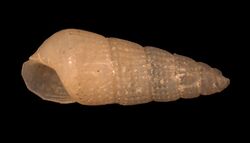Biology:Turbonilla interrupta
From HandWiki
Short description: Species of gastropod
| Turbonilla interrupta | |
|---|---|

| |
| Scientific classification | |
| Domain: | Eukaryota |
| Kingdom: | Animalia |
| Phylum: | Mollusca |
| Class: | Gastropoda |
| Subclass: | Heterobranchia |
| Family: | Pyramidellidae |
| Genus: | Turbonilla |
| Species: | T. interrupta
|
| Binomial name | |
| Turbonilla interrupta (Totten, 1835) [1]
| |
| Synonyms[2] | |
| |
Turbonilla interrupta, common name the interrupted turbonille, is a species of sea snail, a marine gastropod mollusk in the family Pyramidellidae, the pyrams and their allies.[2][3][4][5][6]
Description
The shell grows to a length of 8 mm.
Distribution
This species occurs in the following locations:[2]
- Caribbean Sea: Cuba, Venezuela
- Gulf of Mexico: Mexico
- Lesser Antilles
- Atlantic Ocean: Gulf of Maine, Gulf of St Lawrence (Canada), Azores, Argentina
- Puerto Rico
- United Kingdom Exclusive Economic Zone
- Mediterranean Sea.
Notes
Additional information regarding this species:[2]
- Diet: generally for group, planktonic and minute detrital food items through either suspension or deposit feeding
- Dimensions: maximum size of 6 to 8 mm
- Distribution: Range: 47°N to 41.7°S; 97.7°W to 37°W. Distribution: Canada; Canada: Gulf of St. Lawrence, Nova Scotia; USA: Massachusetts, Rhode Island, New York, New Jersey, Georgia, Florida; Florida: East Florida, West Florida; USA: Louisiana, Texas; Mexico; Mexico: Tabasco, Veracruz, Campeche State, Yucatán State, Quintana Roo; Venezuela; Venezuela: Falcon; St. Vincent & the Grenadines: Grenada; Barbados, Brazil; Brazil: Amapa, Para, Ceara, Rio Grande do Norte, Rio de Janeiro, São Paulo, Parana; Uruguay, Argentina; Argentina: Buenos Aires, Rio Negro
- Habitat: infralittoral of the Gulf and estuary
- Reproduction: sexes are separate but are seldom conspicuously different externally, simultaneous hermaphrodites yet self-fertilization is prevented due to various morphological, physiological, or behavioral mechanisms; generally, marine gastropods shed their eggs
References
- ↑ Totten, J. G. 1835. Description of some new shells, belonging to the coast of New England. No. 2. American Journal of Science and Arts 28: 347-353, 1 pl
- ↑ 2.0 2.1 2.2 2.3 Bouchet, P. (2011). Turbonilla interrupta (Totten, 1835). Accessed through: World Register of Marine Species at http://www.marinespecies.org/aphia.php?p=taxdetails&id=160082 on 2012-03-01
- ↑ ITIS database
- ↑ Brunel, P., L. Bosse, and G. Lamarche. 1998. Catalogue of the marine invertebrates of the estuary and Gulf of St. Lawrence. Canadian Special Publication of Fisheries and Aquatic Sciences, 126. 405 p.
- ↑ Rosenberg, G. 2004. Malacolog Version 3.3.2: Western Atlantic gastropod database. The Academy of Natural Sciences, Philadelphia, PA.
- ↑ Rosenberg, G., F. Moretzsohn, and E. F. García. 2009. Gastropoda (Mollusca) of the Gulf of Mexico, Pp. 579–699 in Felder, D.L. and D.K. Camp (eds.), Gulf of Mexico–Origins, Waters, and Biota. Biodiversity. Texas A&M Press, College Station, Texas.
- Holmes, F. S. 1859. Post-Pleiocene fossils of South-Carolina. 65-98, pls. 11-14. Russell & Jones: Charleston, South Carolina
- Verrill, A. E. 1873. Report on the invertebrate animals of Vineyard Sound and the adjacent waters, with an account of the physical characters of the region. United States Commission of Fish and Fisheries, Report, 1871 and 1872: 295-778, pls. 1-18.
- Bush, K. J. 1899. Descriptions of new species of Turbonilla of the Western Atlantic fauna, with notes on those previously known. Proceedings of the Academy of Natural Sciences of Philadelphia 51: 145-177, pl. 8.
- Bartsch, P. 1909. Pyramidellidae of New England and the adjacent region. Proceedings of the Boston Society of Natural History 34: 67-113, pls. 11-14.
- Bush, K. J. 1909. Notes on the family Pyramidellidae. American Journal of Science 27: 475-484.
External links
- To Biodiversity Heritage Library (60 publications)
- To Encyclopedia of Life
- To USNM Invertebrate Zoology Mollusca Collection
- To ITIS
- To World Register of Marine Species
Wikidata ☰ Q3735640 entry
 |

